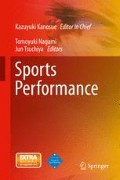Abstract
Optimisation is often used in an attempt to explain technique adopted in skilled sport performance. This might take the form of minimising joint torques in an expectation that the optimum simulated technique will resemble the actual performance. If a suitable optimisation criterion can be identified then this may give some insight into the adopted technique. In all human movement there is inherent variation so that no two performances are exactly the same. As a consequence skilled technique needs to be successful in a noisy environment and so optimised technique also needs to be robust to the inherent variation in coordination. In movements in which there is sufficient time for feedback control to operate it is to be expected that there will be greater variation in technique in those phases that adjustments are made. It is also to be expected that there will be little variation in technique for those phases where accurate coordination is crucial to the success of the movement. The aspect that often governs elite technique is that of achieving consistent success rather than some biomechanical measure of movement.
Access this chapter
Tax calculation will be finalised at checkout
Purchases are for personal use only
References
Anderson FC, Pandy MG (2001) Dynamic optimisation of human walking. ASME J Biomech Eng 123:381–390
Arampatzis D, Brüggemann G-P (1999) Mechanical and energetic processes during the giant swing exercise before dismount and flight elements on the high bar and uneven parallel bars. J Biomech 32:811–820
Brüggemann G-P, Cheetham PJ, Alp Y, Arampatzis D (1994) Approach to a biomechanical profile of dismounts and release-regrasp skills of the high bar. J Appl Biomech 10:291–312
Davis J (2005) Undersomersaults on parallel bars. Gym Craft 14:6–7
Fédération Internationale de Gymnastique (2009) Code of points. F.I.G, Moutier
Hiley MJ, Yeadon MR (2003a) Optimum technique for generating angular momentum in accelerated backward giant circles prior to a dismount. J Appl Biomech 19:119–130
Hiley MJ, Yeadon MR (2003b) The margin for error when releasing the high bar for dismounts. J Biomech 36:313–319
Hiley MJ, Yeadon MR (2005) Maximal dismounts from high bar. J Biomech 38:2221–2227
Hiley MJ, Yeadon MR (2008) Optimisation of high bar circling technique for consistent performance of a triple piked somersault dismount. J Biomech 41:1730–1735
Hiley MJ, Yeadon MR (2012) The effect of cost function on optimum technique of the undersomersault on parallel bars. J Appl Biomech 28:10–19
Hiley MJ, Yeadon MR (2013) Investigating optimal technique in a noisy environment: application to the upstart on uneven bars. Hum Mov Sci 32:181–191
Hiley MJ, Zuevsky VV, Yeadon MR (2013) Is skilled technique characterised by high or low variability? – An analysis of high bar giant circles. Hum Mov Sci 31:171–180
Irwin G, Kerwin DG (2007) Musculoskeletal work of high bar progressions. Sports Biomech 6:360–373
Ren L, Jones RK, Howard D (2007) Predictive modelling of human walking over a complete gait cycle. J Biomech 40:1567–1574
Wolpert DM (2007) Probabilistic models in human sensorimotor control. Hum Mov Sci 26:511–524
Yamasaki T, Gotoh K, Xin X (2010) Optimality of a kip performance on the high bar: an example of skilled goal-directed whole body movement. Hum Mov Sci 29:464–482
Yeadon MR (1993) The biomechanics of twisting somersaults: Part III: Aerial twist. J Sport Sci 11:209–218
Yeadon MR (2002) The control of twisting somersaults using asymmetrical arm movements. In: IV World Congress of Biomechanics Proceedings, Calgary, pp 40–41
Yeadon MR, Hiley MJ (2000) Mechanics of the backward giant circle on the high bar. Hum Mov Sci 19:153–173
Yeadon MR, Knight JP (2012) A virtual environment for learning to view during aerial movements. Compt Methods Biomech 15:919–924
Yeadon MR, Mikulcik EC (1996) The control of non-twisting somersaults using configurational changes. J Biomech 29:1341–1348
Yeadon MR, Mikulcik EC (2000) Stability and control of aerial movements. In: Nigg BM, MacIntosh BR (eds) Biomechanics and biology of movement. Human Kinetics, Champaign, pp 211–221
Yeadon MR, Trewartha G (2003) Control strategy for a hand balance. Motor Control 7:411–430
Author information
Authors and Affiliations
Corresponding author
Editor information
Editors and Affiliations
Rights and permissions
Copyright information
© 2015 Springer Japan
About this chapter
Cite this chapter
Hiley, M., Yeadon, M.R.(. (2015). Optimal Technique, Variability and Control in Gymnastics. In: Kanosue, K., Nagami, T., Tsuchiya, J. (eds) Sports Performance. Springer, Tokyo. https://doi.org/10.1007/978-4-431-55315-1_23
Download citation
DOI: https://doi.org/10.1007/978-4-431-55315-1_23
Publisher Name: Springer, Tokyo
Print ISBN: 978-4-431-55314-4
Online ISBN: 978-4-431-55315-1
eBook Packages: MedicineMedicine (R0)

